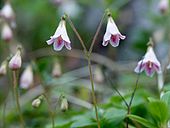
Subshrub
Encyclopedia

Woody plant
A woody plant is a plant that uses wood as its structural tissue. These are typically perennial plants whose stems and larger roots are reinforced with wood produced adjacent to the vascular tissues. The main stem, larger branches, and roots of these plants are usually covered by a layer of...
. Prostrate shrub
Prostrate shrub
A prostrate shrub is a woody plant, most of the branches of which lie upon or just under the ground, rather than being held erect as are the branches of most trees and shrubs....
is a similar term.
It is distinguished from a shrub
Shrub
A shrub or bush is distinguished from a tree by its multiple stems and shorter height, usually under 5–6 m tall. A large number of plants may become either shrubs or trees, depending on the growing conditions they experience...
by its ground-hugging stems and lower height, with overwintering perennial woody growth typically less than 10–20 cm tall, or by being only weakly woody and/or persisting only for a few years.
Small, low shrubs such as lavender
Lavender
The lavenders are a genus of 39 species of flowering plants in the mint family, Lamiaceae. An Old World genus, distributed from Macaronesia across Africa, the Mediterranean, South-West Asia, Arabia, Western Iran and South-East India...
, periwinkle
Vinca
Vinca is a genus of six species in the family Apocynaceae, native to Europe, northwest Africa and southwest Asia. The English name periwinkle is shared with the related genus Catharanthus .-Description:Vinca plants are subshrubs or herbaceous, and have slender trailing stems 1–2 m long...
, and thyme
Thyme
Thyme is a culinary and medicinal herb of the genus Thymus.-History:Ancient Egyptians used thyme for embalming. The ancient Greeks used it in their baths and burnt it as incense in their temples, believing it was a source of courage...
, and many members of the family Ericaceae
Ericaceae
The Ericaceae, commonly known as the heath or heather family, is a group of mostly calcifuge flowering plants. The family is large, with roughly 4000 species spread across 126 genera, making it the 14th most speciose family of flowering plants...
, such as cranberries
Cranberry
Cranberries are a group of evergreen dwarf shrubs or trailing vines in the subgenus Oxycoccus of the genus Vaccinium. In some methods of classification, Oxycoccus is regarded as a genus in its own right...
, are often classed as subshrubs.
Definition
A chamaephyte or dwarf-shrub is a plant that bears hibernating buds on persistent shoots near the ground – usually woody plants with perennating buds borne close to the ground, no more than 25 centimetres (9.8 in) above soil surface. One significance of the closeness to the ground is that the buds remain within the surface boundary layer and are thus somewhat protected from harsh winter winds.Chamaephytes are especially important in stressful environments, for example in alpine, arctic or dry ecosystems, often grazed by herbivore
Herbivore
Herbivores are organisms that are anatomically and physiologically adapted to eat plant-based foods. Herbivory is a form of consumption in which an organism principally eats autotrophs such as plants, algae and photosynthesizing bacteria. More generally, organisms that feed on autotrophs in...
s, and on nutrient-poor soils or rock
Rock (geology)
In geology, rock or stone is a naturally occurring solid aggregate of minerals and/or mineraloids.The Earth's outer solid layer, the lithosphere, is made of rock. In general rocks are of three types, namely, igneous, sedimentary, and metamorphic...
.
Examples
Prominent examples are many of the species of maquisMaquis shrubland
thumb|220px|Low Maquis in Corsica.220px|thumb|High macchia in Sardinia.Maquis or macchia is a shrubland biome in the Mediterranean region, typically consisting of densely growing evergreen shrubs such as holm oak, tree heath, strawberry tree, sage, juniper, buckthorn, spurge olive and myrtle...
and other submediterranean dry ecosystems (such as thyme, Thymus vulgaris
Thymus vulgaris
Thymus vulgaris or common thyme is a low growing herbaceous plant, sometimes becoming somewhat woody. It is native to southern Europe, where it is often cultivated as a culinary herb....
, and rosemary, Rosmarinus officinalis), the different heather species (e.g. Calluna vulgaris and Erica
Erica
Erica ,the heaths or heathers, is a genus of approximately 860 species of flowering plants in the family Ericaceae. The English common names "heath" and "heather" are shared by some closely related genera of similar appearance....
species), African wild olive (Olea europaea ssp. cuspidata) and edelweiss (Leontopodium alpinum). The term chamaephyte is particularly used within the context of Raunkiær plant life-forms.
Chamaephytes also include cushion plant
Cushion plant
A cushion plant is a compact, low growing, mat forming plant that is found in alpine, subalpine, arctic, or subarctic environments around the world...
s.

